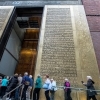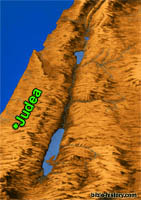A GENERAL GEOGRAPHICAL OVERVIEW
THE LAND
An understanding of the geography of the ancient world is of tremendous value in understanding the Bible. It is my conviction that a good Bible atlas is an essential tool for any serious student of the Bible, that is why I felt the need to create a tool like this. The brief notes that follow are for you to read and follow along on the map. We will begin with the area to the north of the Persian Gulf. Click on the below map to get a picture of this area.
Map of the Near East in Abraham's Time
Two rivers flow into the Persian Gulf: the Euphrates and, farther to the east, the Tigris. Between these rivers lies a valley which is usually called simply the Tigris and Euphrates River Valley. Beginning with this valley and moving north and northwest, then back down the coast of the Mediterranean and into Egypt is a geographical feature known as the Fertile Crescent, which has long been regarded as the cradle of civilization. It is within this area that most of the events of the Old Testament take place.
Modern-day Israel occupies that land which once made up ancient Palestine (and before that Canaan). Modern Syria and Lebanon together make up what was once known simply as Syria, which lay along the northern portion of the eastern Mediterranean seaboard, bordering Palestine to the north. Be sure to note the difference between Syria, and Assyria. The latter was a kingdom which occupied the northern part of the Tigris-Euphrates valley, that area which is today encompassed by Iraq. The Old Testament is largely concerned with the areas of Babylonia - in the southern portion of the Tigris-Euphrates valley, on the northern end of the Persian Gulf - and Assyria in the Tigris- Euphrates valley, of Syria and Palestine (also known as Canaan), and of Egypt.
Now follow along on the big map. You can always access it by pressing the "contents" button at the top left. Let's take a brief look specifically at the land of Palestine, beginning with a discussion of its distinctive topographical features. You may want to remember that this information is covered in more detail in the section called "Physical Features" located at the bottom left on the big Map
That part of Palestine which lies to the West of the Jordan River encompasses only about 6000 square miles. The land of Israel has traditionally stretched from Beersheba in the south up to Mount Hermon above Dan (Danos on the map) in the north, a distance of only about 150 miles. From the Sea of Galilee to the Mediterranean is a distance of 28 miles, while from the Sea of Galilee to the Dead Sea in the south is twice that - about 54. Thus we are dealing with an area which is much smaller than most people realize.
Probably one of the most important distinctives of Palestinian geography is its terrain, which is very rugged indeed. Proceeding from the Mediterranean in the West to the desert to the east of the Jordan River, the land is divided into five distinct geographical areas. Running north and south along the Mediterranean coastline is the Coastal Plain, sometimes also referred to as the Plain of Sharon. This is the only really fertile area of Palestine. Unfortunately it also happens to be the only really feasible route
between Egypt and the empires to the east. As such, it was often responsible for entangling Israel in the affairs of the other nations of the region.
Moving inland from the Coastal Plain one comes next to the the shepha (or shephila) - the foot hills. From these one passes on up into the rugged, mountainous areas of Palestine, which are usually referred to simply as the Hill Country. It is here, among other things, that one will find the city of Jerusalem. To the east the hill country drops off rapidly into the valley of the Jordan, and, on the far side of Jordan, to the plateau area which in turn moves into the Arabian desert.
Of particular note in all this is the elevation of the country. Jerusalem, in the Hill Country, sits about 2600 feet above sea level, yet the shoreline of the Dead Sea 15 miles away is 1200 feet below sea level. Thus, in a fifteen mile distance measured horizontally we have a drop in elevation of almost 4000 feet. This is why, for example, in the story of the Good Samaritan, Jesus begins by saying 'a certain man was going DOWN from Jerusalem to Jericho.' Can you imagine the descent?
This ruggedness of the land dominates much of the history of Palestine. In times of danger the people of Palestine lived in the hills, where they were relatively safe from enemies and easily defended. Historically, their major military defeats came only when they moved out into the plains area or the foothills.
One other dramatic feature must be mentioned in any discussion of geography. Stretching roughly from Mount Carmel, to the West of the Sea of Galilee, all the way across Palestine is a flat area or plain sometimes called the Plain of Jezreel or the Plain of Esdraelon, this area even today serves as the breadbasket of Israel. Overlooking this plain is a fair-sized hill on top of which sat an ancient city called Megiddo. Militarily, whoever controlled this city controlled the plain, and with it most of Palestine. Historically, most of the major battles were fought in and around this hill. The Hebrew word for 'hill' is 'har', and this hill on which Megiddo sat was called 'Har-megiddo' - the Hill of Megiddo - which transliterated into Greek is Armaggedon. This then is where we get our image of Armageddon as a decisive battle and, ultimately, as the final battle of all of human history before the return of the Lord.
The climate of Palestine is relatively mild, with an average year round temperature in the 60s. The major problem faced by occupants of the land in their daily lives was that of water. Sixty miles to the east of the mountains is desert, and, to the West, moisture-laden winds off the Mediterranean bring ample rain to the plains, but on the east side of the mountains there is very little precipitation. When water did come, it was usually in the form of torrents pouring off the mountains to wash away shrub, dirt and any straying animals or people caught unawares. Polluted as it was with mud and debris, it is poorly suited to provide residents with the water they need for livestock or fields.
With the problem of water so acute, then, and so constantly in the forefront of the minds of the people, it is easy to see how the abundance of water to drink and to harvest became a central prophetic image in the writings of the Old Testament prophets. Ezekiel, for example, when he prophesies of a New Jerusalem, envisions it as a city with an overabundance of water - water to swim in. And in the Twenty-Third Psalm we read 'The Lord is my shepherd; I shall not want.... He leads me beside the still waters'; a paradisical image for any farmer whose only experience with large quantities of water was as torrential floods from the mountains.
Now that we have discussed the general overview of the Geography of Palestine, take some time to read
the more detailed Physical Features of Palestine section.
© Free Bible https://free-bible.com
Read The Bible
- 1599 Geneva Bible (GNV)
- 21st Century King James Version (KJ21)
- American Standard Version (ASV)
- Amplified Bible (AMP)
- Amplified Bible, Classic Edition (AMPC)
- Authorized (King James) Version (AKJV)
- BRG Bible (BRG)
- Christian Standard Bible (CSB)
- Common English Bible (CEB)
- Complete Jewish Bible (CJB)
- Contemporary English Version (CEV)
- Darby Translation (DARBY)
- Disciples’ Literal New Testament (DLNT)
- Douay-Rheims 1899 American Edition (DRA)
- Easy-to-Read Version (ERV)
- English Standard Version (ESV)
- English Standard Version Anglicised (ESVUK)
- Evangelical Heritage Version (EHV)
- Expanded Bible (EXB)
- GOD’S WORD Translation (GW)
- Good News Translation (GNT)
- Holman Christian Standard Bible (HCSB)
- International Children’s Bible (ICB)
- International Standard Version (ISV)
- J.B. Phillips New Testament (PHILLIPS)
- Jubilee Bible 2000 (JUB)
- King James Version (KJV)
- Lexham English Bible (LEB)
- Living Bible (TLB)
- Modern English Version (MEV)
- Mounce Reverse Interlinear New Testament (MOUNCE)
- Names of God Bible (NOG)
- New American Bible (Revised Edition) (NABRE)
- New American Standard Bible (NASB)
- New American Standard Bible 1995 (NASB1995)
- New Catholic Bible (NCB)
- New Century Version (NCV)
- New English Translation (NET)
- New International Reader's Version (NIRV)
- New International Version - UK (NIVUK)
- New International Version (NIV)
- New King James Version (NKJV)
- New Life Version (NLV)
- New Living Translation (NLT)
- New Matthew Bible (NMB)
- New Revised Standard Version (NRSV)
- New Revised Standard Version Catholic Edition (NRSVCE)
- New Revised Standard Version, Anglicised (NRSVA)
- New Revised Standard Version, Anglicised Catholic Edition (NRSVACE)
- New Testament for Everyone (NTE)
- Orthodox Jewish Bible (OJB)
- Revised Geneva Translation (RGT)
- Revised Standard Version (RSV)
- Revised Standard Version Catholic Edition (RSVCE)
- The Message (MSG)
- The Voice (VOICE)
- Tree of Life Version (TLV)
- World English Bible (WEB)
- Worldwide English (New Testament) (WE)
- Wycliffe Bible (WYC)
- Young's Literal Translation (YLT)
Table of Contents
Main Menu
- Ancient Assyrian Social Structure
- Ancient Babylonia
- Ancient Canaan During the Time of Joshua
- Ancient History Timeline
- Ancient Oil Lamps
- Antonia Fortress
- Archaeology of Ancient Assyria
- Assyria and Bible Prophecy
- Augustus Caesar
- Background Bible Study
- Bible
- Biblical Geography
- Fallen Empires - Archaeological Discoveries and the Bible
- First Century Jerusalem
- Glossary of Latin Words
- Herod Agrippa I
- Herod Antipas
- Herod the Great
- Herod's Temple
- High Priest's in New Testament Times
- Jewish Literature in New Testament Times
- Library collection
- Map of David's Kingdom
- Map of the Divided Kingdom - Israel and Judah
- Map of the Ministry of Jesus
- Matthew Henry Bible Commentary
- Messianic Prophecy
- Nero Caesar Emperor
- Online Bible Maps
- Paul's First Missionary Journey
- Paul's Second Missionary Journey
- Paul's Third Missionary Journey
- Pontius Pilate
- Questions About the Ancient World
- Tabernacle of Ancient Israel
- Tax Collectors in New Testament Times
- The Babylonian Captivity
- The Black Obelisk of Shalmaneser
- The Books of the New Testament
- The Court of the Gentiles
- The Court of the Women in the Temple
- The Destruction of Israel
- The Fall of Judah with Map
- The History Of Rome
- The Incredible Bible
- The Jewish Calendar in Ancient Hebrew History
- The Life of Jesus in Chronological Order
- The Life of Jesus in Harmony
- The Names of God
- The New Testament
- The Old Testament
- The Passion of the Christ
- The Pharisees
- The Sacred Year of Israel in New Testament Times
- The Samaritans
- The Scribes
Ancient Questions
- Why Do the Huldah Gates Appear Different in Ancient Replicas and Modern Photos?
- What Is the Origin of the Japanese and Chinese Peoples? A Biblical Perspective
- How did the ancient Greeks and Romans practice medicine and treat illnesses?
- What were the major contributions of ancient Babylon to mathematics and astronomy?
- How did the ancient Persians create and administer their vast empire?
- What were the cultural and artistic achievements of ancient India, particularly during the Gupta Empire?
- How did ancient civilizations like the Incas and Aztecs build their remarkable cities and structures?
- What were the major trade routes and trading practices of the ancient world?
- What was the role of slavery in ancient societies like Rome and Greece?
- How did the ancient Mayans develop their sophisticated calendar system?
Bible Study Questions
- Why Do Christians Celebrate Christmas?
- How Many Chapters Are There in the Bible?
- The Five Key Visions in the New Testament
- The 400-Year Prophecy: Unpacking Genesis 15 and the Journey of a People
- The Authorized (King James) Version (AKJV): Historical Significance, Translation Methodology, and Lasting Impact
- Exploring the English Standard Version (ESV): Its Aspects, Comparisons, Impact on Biblical Studies, and Church Use
- A Detailed Historical Analysis of Language Updates in the KJ21: Comparison with Other Versions
- A Detailed Historical Analysis of the American Standard Version (ASV): Comparison to the King James Version, Influence on Later Translations, and Evaluation of Strengths and Weaknesses
- A Detailed Historical Analysis of Amplifications in the Amplified Bible (AMP) and Its Comparison to Other Bible Translations
- Detailed Historical Analysis of the Amplified Bible Classic Edition (AMPC): Examples of Amplifications and Comparative Analysis with Other Bible Translations
About
Welcome to Free Bible: Unearthing the Past, Illuminating the Present! Step into a world where ancient history and biblical narratives intertwine, inviting you to explore the rich tapestry of human civilization.
Discover the captivating stories of forgotten empires, delve into the customs and cultures of our ancestors, and witness the remarkable findings unearthed by dedicated archaeologists.
Immerse yourself in a treasure trove of knowledge, where the past comes alive and illuminates our understanding of the present.
Join us on this extraordinary journey through time, where curiosity is rewarded and ancient mysteries await your exploration.
Recent posts
-

The Role of AI in Cryptocurrency Trading and Blockchain Security
Artificial Intelligence (AI) is rapidly reworking industries, and the cryptocurrency sector is not any exception. From enhancing trading techniques to... -

The impact of IP address on LinkedIn traffic
IP address has a serious impact on LinkedIn traffic. Before you start working with the site, you should clarify the specifics of this influence and ho... -

The Bible in Museums: Where to See Ancient Scripture Today
The Bible, as one of the most influential books in human history, has shaped not only religious beliefs but also the course of civilization. Its stori... -

How AI is Revolutionizing 2025: Latest Innovations and Industry Applications
Artificial Intelligence (AI) has turn out to be one of the maximum transformative technologies of the twenty first century. As we flow via 2025, AI ke... -

AI-Powered Innovation: How Businesses Are Leveraging AI for Growth
Artificial Intelligence (AI) is no longer a futuristic concept however a fundamental driving force of innovation in these days’s commercial enterpri...
